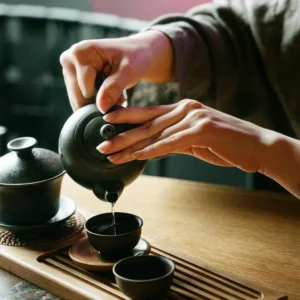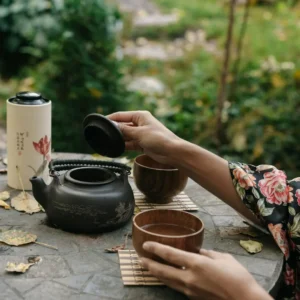Mindful Tea Practice: The Japanese Ceremony Explained
Mindful tea practice reveals how the Japanese tea ceremony embodies Zen philosophy, respect, and graceful human connection. It represents mindfulness, respect, and harmony. Rooted in Zen philosophy, it encourages calm reflection. At the same time, it fosters social grace through kindness and thoughtful interaction. Every gesture carries meaning, and every detail reflects centuries of cultural tradition.
Mindful Tea Practice: The Essence of the Tea Ceremony
 The tea ceremony, also known as chanoyu or sado, is about more than drinking tea. Instead, it is a way of life. The ritual highlights the importance of living in the present moment. Participants focus on simple actions like pouring water, folding cloths, or bowing politely. Each step invites stillness and clarity.
The tea ceremony, also known as chanoyu or sado, is about more than drinking tea. Instead, it is a way of life. The ritual highlights the importance of living in the present moment. Participants focus on simple actions like pouring water, folding cloths, or bowing politely. Each step invites stillness and clarity.
Zen Principles in Action
Zen philosophy teaches awareness, balance, and acceptance. The tea ceremony brings these principles to life. For example, preparing the tea requires patience and focus. Guests must watch closely and respond with humility. Silence often plays a role, allowing space for thought. This quietness reflects Zen values, where inner peace matters more than outward show.
Beauty in Simplicity
Another Zen idea is wabi-sabi, which finds beauty in imperfection. The tea ceremony uses plain utensils, handmade bowls, and natural textures. Rather than perfection, it celebrates honesty and authenticity. Even a cracked cup can carry charm. By embracing imperfection, hosts and guests learn gratitude and appreciation for the moment.
Mindful Tea Practice: Social Grace Through Ritual
The tea ceremony also represents refined manners and social connection. Every movement shows respect for others. From the host’s bow to the guest’s thank you, each action strengthens bonds.
Respect in Small Gestures
Guests enter the tea room after cleansing their hands and mouth. This act shows purity and readiness. They bow to the host, who bows back with equal care. Even receiving a bowl of tea involves careful handling. Guests admire the cup, rotate it slightly, and sip politely. These rituals may seem small, but they reflect deep respect.
Building Human Connection
The tea room is designed to create equality. Its low entrance requires all guests to bow when entering. This simple action removes status differences. Everyone becomes equal, whether samurai, scholar, or farmer. Inside, conversation flows gently, often about nature or art. Thus, the tea ceremony becomes a bridge between people, built on humility and kindness.
The Role of the Tea Room
 The setting of the tea ceremony matters deeply. The tea room, or chashitsu, is built to inspire reflection.
The setting of the tea ceremony matters deeply. The tea room, or chashitsu, is built to inspire reflection.
A Space of Harmony
The tea room is usually small, with soft lighting and simple design. Natural wood, tatami mats, and sliding doors create calm. A flower arrangement or hanging scroll adds beauty, but never excess. This space mirrors Zen ideals – quiet, balanced, and uncluttered. Guests can leave daily worries behind as they step inside.
Nature as a Teacher
Often, the tea room stands near a garden. Then, guests walk along stone paths, passing moss, trees, and flowing water. As a result, this journey prepares the mind for stillness. In fact, Zen teaches patience and balance through nature. Moreover, the garden visit reminds guests that beauty exists in every season, even in falling leaves or drifting snow.
Mindful Tea Practice: Learning from the Tea Ceremony
The tea ceremony may seem distant from modern life. Yet its lessons remain relevant today.
Mindfulness in Daily Life
The ritual teaches that even simple acts can hold meaning. Preparing a meal, sharing coffee, or setting a table can become mindful. By slowing down, people can notice beauty in small details. This practice reduces stress and encourages peace.
The Value of Respect
In a world that often feels rushed, the tea ceremony reminds us of the value of respect. Greeting someone warmly or listening carefully can transform interactions. These gestures, though simple, create stronger connections.
A Balance Between Self and Others
Finally, the tea ceremony shows how to balance self-awareness with care for others. Hosts express creativity in their preparation, while guests show gratitude. This balance builds harmony. It reminds us that life flows better when we combine self-expression with respect.
Conclusion
The Japanese tea ceremony embodies Zen philosophy and social grace. Moreover, through silence, simplicity, and ritual, it teaches mindfulness and respect. Furthermore, every bow, every sip, and every pause reminds us to live with care. Although the tea ceremony belongs to Japanese tradition, its lessons belong to everyone. Therefore, by practising mindfulness, embracing imperfection, and showing respect, we can carry its spirit into daily life. In fact, mindful tea practice reveals how the Japanese tea ceremony embodies Zen philosophy, respect, and graceful human connection.
